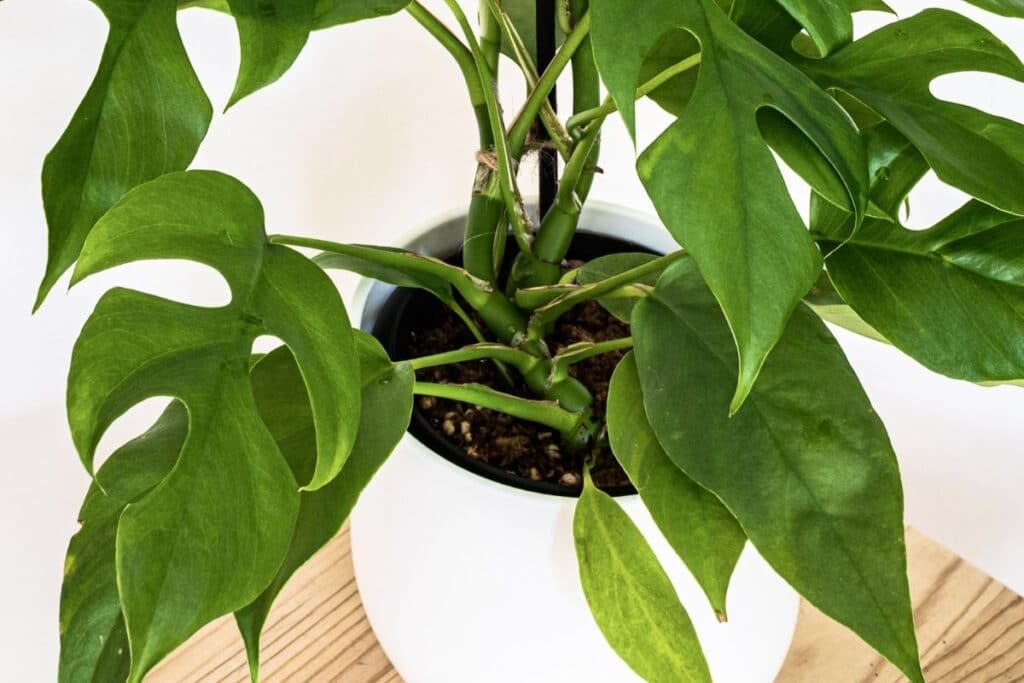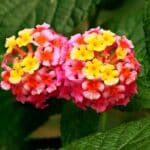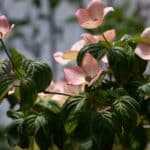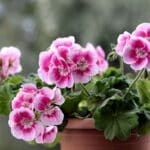The rhaphidophora tetrasperma is a plant that is growing in popularity. Often mistaken for a miniature monstera plant, many refer to it as a mini monstera, mini split-leaf, or a Ginny philodendron—although it is not related to any of these varieties.
This plant looks a bit like the bigger Monstera deliciosa or Split Leaf Philodendron, but it is actually in the genus Rhaphidophora.
Also known as Philodendron ‘Piccolo,’ Philodendron ‘Ginny,’ and ‘Mini Monstera,’ this plant is most commonly referred to by its scientific name—rhaphidophora tetrasperma, that is.
Rhaphidophora tetrasperma may be a mouthful to say, but this plant makes a beautiful addition to any home. The uniqueness of the leaves is one of the reasons why this plant is so popular—the low-maintenance care may also be a factor.
These plants are most commonly grown as an indoor house plant due to their intolerability to frost, but they can also be grown outside in zones where frost is not a possibility.
What is Rhaphidophora Tetrasperma Plant?
The rhaphidophora tetrasperma is an evergreen vining plant with unique-looking leaves that look as though they have been cut into. These leaves grow to be up to twelve inches in length at their peak, but they will probably stay closer to six inches if kept as a houseplant.
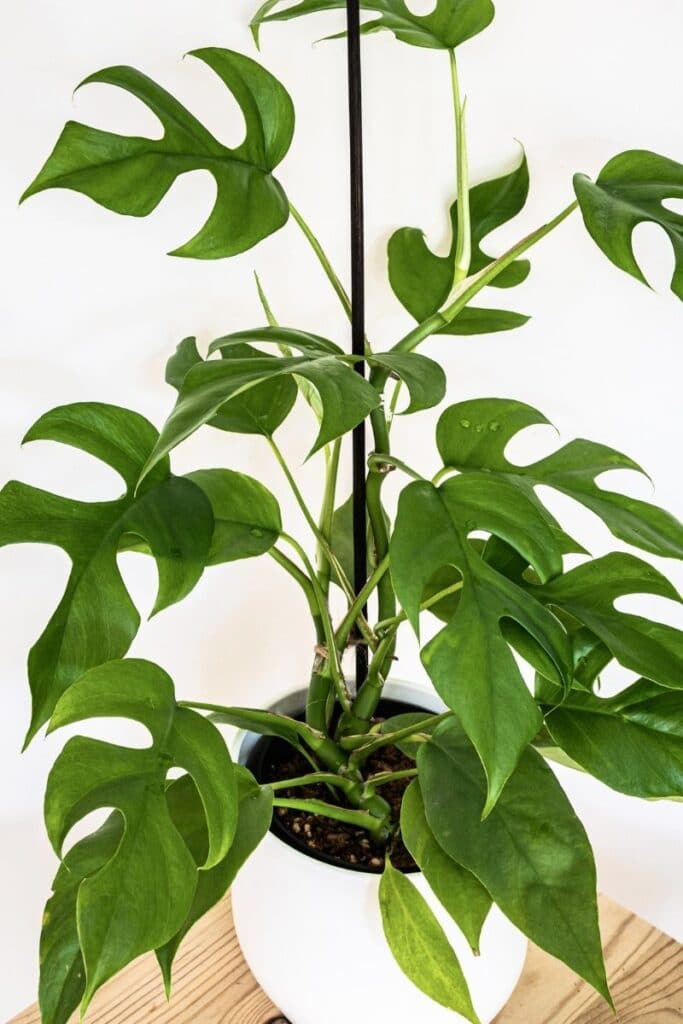
This plant uses its aerial roots to climb. Aerial roots are small tendrils that grow out from the vine. These tendrils can stick to and climb up surfaces with slightly rough textures such as brick, bark, and stone.
The natural habitat for a rhaphidophora tetrasperma plant is tropical southern Thailand and Malaysia, so they are accustomed to warm and humid climates. For this reason, it is difficult to grow these plants exclusively outside in the United States, but some have had luck in zones eleven and twelve.
In cooler growing zones, you may be able to leave your plant outside during the summer months, but once temperatures drop below 55 degrees Fahrenheit, the plant will need to be brought inside.
Under ideal conditions, these plants can grow to reach heights of up to twelve feet—double the height of the average adult man. When kept as a houseplant, however, your rhaphidophora tetrasperma plant will probably grow between four and five feet tall when cared for properly.
How to Care for Rhaphidophora Tetrasperma
When caring for a rhaphidophora tetrasperma plant, there are a few key aspects to consider as this plant does have some specific requirements. Thankfully, the demands of the rhaphidophora tetrasperma are reasonable, making it a fairly easy plant to care for overall.
Light
Although the rhaphidophora tetrasperma does require a decent amount of bright light, it needs bright indirect light. The leaves are fairly delicate and can’t tolerate much direct sun exposure. Too little light, however, can also be detrimental.
If keeping your tropical plant inside, it is generally best to keep it within the center of a room that receives a lot of sun as opposed to directly in a window sill as preferred by many other indoor plants.
You may choose to move your plant around the house as needed to ensure it gets enough indirect sunlight throughout the day.
If you are in a warm enough climate to grow your rhaphidophora tetrasperma in the ground outside, or if you are keeping your potted plant outside during the summer, it is even more important to ensure that it does not receive much direct sunlight.
If you cannot avoid locations that receive direct sunlight, using a shade cloth during periods of strong sun exposure can help protect your leaves from scorching.
Temperature
Temperature is another important factor when it comes to caring for your rhaphidophora tetrasperma plant. As mentioned previously, this plant has no frost resistance, and it will not survive even the lightest frost conditions.
Any temperature below 55 degrees Fahrenheit can be harmful to this plant, especially if exposed for more than a few hours.
Prime temperatures for this plant are between 55 and 85 degrees Fahrenheit. To keep the plant from getting too warm, shade is very important. In their natural environment, these plants grow under the canopies of much larger plants and trees and are kept cool by their shade.
Water/ Humidity
Allowing the fresh soil to dry out around your rhaphidophora tetrasperma plant can be detrimental to the health of your plant. These plants require constant moisture; this comes from the highly humid environments that they are native to.
There is a fine line when it comes to keeping your plant’s soil moist while not saturating the roots. You should keep it watered just enough to have the soil lightly moist at all times—never too wet and never dry.
If your plant is outside, it is a good idea to monitor weather conditions and adjust your watering schedule accordingly. If you are not receiving much rain, more watering may be required.
During the winter months—even if the plant is brought inside—you may be able to cut back on some of the watering. Watering is more important when the plant is in active growth during warmer months and is not as important when the plant is not in active growth.
Soil
Well-draining soil is a key factor in the health and growth of the Monstera minima plant. Soil that has good drainage properties will help keep the roots from becoming waterlogged and can help retain moisture without saturation.
If the soil you are planting in is not particularly sufficient at draining, there are ways to help improve drainage. Adding a mulch, bark, or moss to the surface of the soil is one of the easiest ways to improve drainage.
Adding perlite to your soil will also help to improve drainage while adding organic minerals that may also be beneficial to the plant.
Fertilizer
Although liquid fertilizer can be beneficial to your rhaphidophora tetrasperma, its roots are particularly sensitive and are prone to fertilizer burn.
Fertilizer burn occurs when too much of a certain fertilizer—generally nitrogen—is added to the plant and becomes overwhelming, leaving the plant damaged which can cause yellowing and wilting.
Slow-release fertilizers are generally your best option for your rhaphidophora tetrasperma plants as they are less likely to cause fertilizer burn. Fertilizing is most important during the active growth stages of your plant, and it can be applied biweekly as needed.
Pruning
Pruning is not particularly important to the rhaphidophora tetrasperma unless you need to keep it at a certain size for indoor keeping or overgrowth control. It is best to do any pruning during winter months while the plant is not in active growth.
Only small sections of the plant should be taken at a time – 25% at a time should be the maximum, although less is safer for the plant’s health.
Another reason you may need to prune your rhaphidophora tetrasperma is if any section becomes damaged or diseased. Removing damaged sections of the plant can help keep the rest of the plant healthy by saving energy for the healthy sections.
A diseased or pest-riddled section should also be removed to help prevent spread to other parts of the plant.
Training
The rhaphidophora tetrasperma is a vining plant that likes to climb, so training it early can help you adjust how the vines grow. This plant climbs with the use of aerial roots that grab onto surfaces—as long as they have a slight texture.
Many choose to add a trellis next to their rhaphidophora tetrasperma for climbing support, but you could also use simple stakes or even rope.
If your rhaphidophora tetrasperma starts to outgrow its support, adding an additional, taller support will be necessary or else your plant will start to droop. Another option in place of adding more support is to prune your plant to keep it at a certain height.
As mentioned previously, you will want to prune only small sections at a time to ensure you don’t harm the plant.
Common Pests and Diseases
For the most part the rhaphidophora tetrasperma is a resilient plant that can fight off most pests and diseases, although there are some to look out for.
Knowing which ailments are most common can help you prepare to deal with these problems if they arise. There are some preventative measures that can be taken in most cases as well.
Spider Mites
Spider mites are the most common pest that will bother your rhaphidophora tetrasperma, inside or outside. These pests cause damage to plants by attaching themselves to the leaves of the plant and sucking out the nutrients.
With a large enough infestation, these pests will start to cause yellowing leaves that may eventually die and fall off. The leaves of the rhaphidophora tetrasperma are particularly delicate and are prone to heavy damage by a spider mite infestation.
One of the most natural ways to get rid of your spider mite problem is with the use of neem oil.
Neem oil can be lightly sprayed on infested areas until the pests are gone. You can also use neem oil as a preventative measure by lightly spraying the leaves of your plant every few weeks. If the infestation is too severe, a light pesticide spray may be required.
Root Rot
Although the rhaphidophora tetrasperma plants are generally resilient to diseases, root rot can cause them problems. These plants are highly susceptible to root rot and may not be able to recover once this fungal disease has started to spread.
Root rot is primarily caused by too much water around the roots of the plant, particularly pooled water. This is why well-draining soil is so important for your rhaphidophora tetrasperma plants.
Although they require constant moisture, it is important to make sure the moisture does not become saturated soil.
The only chance at treating root rot in your rhaphidophora tetrasperma plants once it has started is to carefully transplant your plant into a new container with lightly damp soil.
During the transplant, you will need to clean the fungus off the roots with a cloth, being careful to remove all the fungus while not harming the roots—a tricky procedure.
A better alternative is to take steps to prevent the disease by monitoring moisture levels and using soil that is well-draining.
Mealybugs
Mealybugs are most common in warmer environments, making them a common pest for the rhaphidophora tetrasperma which will only grow outside in warm climates.
These pests harm the plant in a similar fashion as the spider mites do; they attach themselves to the leaves of the plant and suck out nutrients. Although these pests are not usually harsh enough to kill the leaves, they can cause yellowing and wilting.
The easiest way to get rid of mealybugs is to wipe them off with a cotton swab dipped in rubbing alcohol. A light pesticide can also be applied to take care of larger infestations. For prevention, spraying neem oil occasionally is an easy way to discourage mealybugs from eating your plants.
Is The Rhaphidophora Tetrasperma Toxic?
Thankfully, rhaphidophora tetrasperma is not toxic to humans, although it can cause complications with pets if ingested.
In fact, all plants in the Araceae family are toxic to many different pets. These plants contain calcium oxalate crystals which are toxic to animals such as cats and dogs.
When calcium oxalate crystals are ingested by cats and dogs, they can lead to stomach pain, lethargy, vomiting, difficulty swallowing, drooling, and mouth stinging. Most animals will be deterred by the external mouth pain and will not ingest much, so this is not often fatal.
The best way to keep your pets safe from your rhaphidophora tetrasperma plants is to keep them out of reach. These vining plants can have enticing low-hanging leaves that are best kept up and out of the way.
FAQs
How often should I water Rhaphidophora?
Water Rhaphidophora when the top inch or two of soil feels dry to the touch. Ensure that the soil is well-draining to prevent waterlogging, which can lead to root rot. Adjust watering frequency based on environmental conditions such as temperature, humidity, and season.
How much light does Rhaphidophora tetrasperma need?
Rhaphidophora tetrasperma, also known as the “Mini Monstera” or “Monstera Ginny,” prefers bright, indirect light. It can tolerate lower light conditions but may not grow as vigorously or produce as many split leaves. Avoid direct sunlight, which can scorch the leaves.
Is Rhaphidophora tetrasperma a climber or crawler?
Rhaphidophora tetrasperma is a climber, known for its aerial roots that attach to surfaces and allow the plant to climb. In its natural habitat, it climbs up trees or other structures using these roots for support. In cultivation, it can be trained to climb a moss pole, trellis, or other support.
Final thoughts
In conclusion, with proper rhaphidophora tetrasperma care, including providing the right amount of light, watering, and humidity, you can enjoy this beautiful plant for many years to come.
Remember, finding a good balance between bright indirect light and avoiding too little light is key for optimal growth. Too little light can cause your plant to grow leggy and produce smaller leaves. If you are unsure about the light levels in your home, a light meter can be a helpful tool.
*Image by depositphotos.com/Maritxu22

